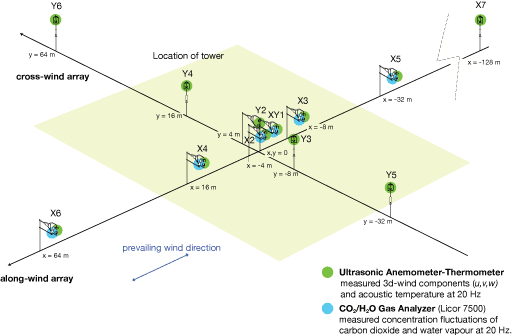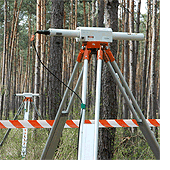|

by Andreas Christen(1,2), Dirk Schindler(3), and Roland Vogt(4)
with scientific contributions from Christian Feigenwinter(4), Irene Lehner(4), Dominik Michel(4), Helmut Mayer(3), Eberhard Parlow(4), Andrea Pitacco(5), and Dieter Scherer(1).
(1) Berlin University of Technology, Institute of Ecology, Berlin, Germany.
(2) University of British Columbia, Department of Geography, Vancouver, Canada.
(3) University of Freiburg, Meteorological Institute, Freiburg, Germany.
(4) University of Basel, Department of Environmental Sciences, Basel, Switzerland.
(5) University of Padova, Department of Environmental Agronomy and Crop Science, Legnaro, Italy.
HX06 was a micrometeorological field experiment designed to determine selected spatial statistics of the flow in the deep canopy layer. In April and May 2006, we probed turbulence and trace-gas exchange in the trunk space of a Scots Pine Forest at the Hartheim Research Station (University of Freiburg, Germany, in German). We addressed in-canopy flow with a planar array of ultrasonic-anemometers, scintillometers, and various gas-analyzers.
|
|
|
 Synchonized data from sixteen ultrasonic anemometer-thermometers are used to to calculate scale-dependent spatial correlation functions. We are interested in the applicability of Taylor's Hypothesis and the convection velocity in the deep canopy, and we separately evaluate this for wind components, temperature and carbon dixoide. Synchonized data from sixteen ultrasonic anemometer-thermometers are used to to calculate scale-dependent spatial correlation functions. We are interested in the applicability of Taylor's Hypothesis and the convection velocity in the deep canopy, and we separately evaluate this for wind components, temperature and carbon dixoide.
Twelve sensors were
horizontally arrayed with spacings between 4 and 192 m along two cardinal axes in the trunk
space. Those sensors were installed at a uniform height of z = 2 m above ground (z/h = 0.13,
where h is canopy height of h = 14.5 m). Six sensors along the first axis were paired with
open-path gas-analyzers (Licor 7500). Additionally, seven sonics were vertically arrayed at a tower at location Y4 reaching up to 27 m. The set-up was run continuously at 20Hz for 30 days
(April 13 to May 13, 2006).
|
|

|
|
 In vegetation canopies, the exchange of sensible heat, momentum and CO2 is not solely driven by turbulent motions (i.e. properties correlated to vertical turbulent motions) but also - at least theoretically - by the local flow around individual canopy elements (i.e. mean properties correlated to the mean vertical wind at a given location). In the framework of spatial averaging the latter process is referred to as dispersive fluxes - spatial correlations in the time-averaged flow.
The setup during HX06 is used to evaluate the importance of dispersive fluxes of momentum, sensible heat and trace-gases in the trunk space of a uniform forest. We recorded simultaneously wind components from sonics and concentration data from multiplexed closed-path gas-analyzers (Li6262, Innova 1312).
In vegetation canopies, the exchange of sensible heat, momentum and CO2 is not solely driven by turbulent motions (i.e. properties correlated to vertical turbulent motions) but also - at least theoretically - by the local flow around individual canopy elements (i.e. mean properties correlated to the mean vertical wind at a given location). In the framework of spatial averaging the latter process is referred to as dispersive fluxes - spatial correlations in the time-averaged flow.
The setup during HX06 is used to evaluate the importance of dispersive fluxes of momentum, sensible heat and trace-gases in the trunk space of a uniform forest. We recorded simultaneously wind components from sonics and concentration data from multiplexed closed-path gas-analyzers (Li6262, Innova 1312).
|
|

|
Two small-aperture scintillometers were operated along with the sonic set-up. We will evaluate the use of scintillometry (whose core assumptions fail in the trunk space), and compare the area integrated mesaurements from the scitillometers with the average values of all sonics.
|
|
Presentations on HX06
Christen A., Scherer D., Schindler D., Vogt R. (2007): 'Two-point statistics of turbulent flow in the canopy layer', International Conference on Wind and Trees August 5-9, Vancouver, BC.
Christen A., Holst J., Scherer D., Schindler D., Vogt R. (2008): 'Dispersive fluxes of momentum, sensible heat and CO2 in a forest canopy', 18th Conference on Atmospheric BioGeosciences / 28th Conference on Agricultural and Forest Meteorology, April 27 - May 2, 2008.
Christen A., Scherer D., Schindler D., Vogt R.
(2008): 'Convection velocities and spatial turbulence statistics
in the trunk space of a forest', AMS 18th Symposium on Boundary Layers and Turbulence, June 9 - 13, 2008.
|
|
|





